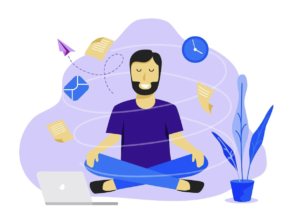
There are many ways or methods to choose from. What most starters are looking for is to simply be able to practice general silent sitting on a regular basis. This post is entirely for those who wish to start with meditation. In this post I’ll stick to the most basic one, which in many ways has found itself to be a synonym for the practice. Let’s call it ‘silent meditation’ or ‘silent sitting’.
THE SETUP
Physical Posture
You can sit a cross-legged position, as shown in the image above. It is recommended that you keep your spine straight, as it helps with attentiveness and breathing. You can keep a back-rest if required. If you’re using one, it is recommend that the back rest is only limited to the lower back and doesn’t extend further up. You can place your hand comfortably at the center or at the top of your knees. Don’t tighten your muscles or apply too much pressure in your body. Close your eyes!
Environment
If you’re indoors, you can sit in a couch, the floor or even your bed. Feel free to place a cushion below you, if required. For indoors, spaces with proper air-flow are recommended. Dark, dim or even lightened spaces can work. While each one can contribute differently, it is better to avoid spaces with extremely bright white lights, as they may steal your focus. Anywhere outdoors is fine as well, as long as you feel comfortable and have no interference from others.
THE PROCESS
General Process
Decide how long you want to meditate and setup a timer accordingly. Alternatively, you can ignore the timer and go for as long as you feel comfortable, and later find out how long your sitting was. Be in the posture explained above, and dedicate your attention to your breathing. While you focus on your breathe in its inhalation and exhalation, just observe the physical sensations and thoughts that come and go. In simple terms—focus on your breathe and watch the rest. When you realize that you’ve gotten distracted, remind yourself of the process.
Setting Your Intention
While you could have an intention or not have one, the most common one for starters is to bring your mind and body to a state of relaxation. For body, when you watch and observe your bodily sensations, you bring them closer to relaxation. For the mind, when you do well with focusing on your breath-work and disentangle yourself from your thoughts, you’re better able to relax your mind.
The process is easier said than done. The ability to focus will definitely be compromised due to immense level of distractions you’ll experience in your first few sittings, but as the practice goes, your body will adapt well to the process.
FREQUENTLY ASKED QUESTIONS
Can I play music in the background?
Yes. Non-lyrical meditation music is fine. It will help you relax and come at peace quicker. It’s not a must as it can possibly be distractive to some. If you’re looking for a link, here’s one— https://www.youtube.com/watch?v=aIIEI33EUqI
I’m having difficulties focusing on my breath. What should I do?
Firstly, don’t worry. Even intermediate practitioners often have this issue. It’s impossible to get over this in only a few sittings. The first priority is to be able to feel comfortable in your posture, which too might take days. Once that milestone’s achieved, people are better able to relax quicker.
What should I think?
Unless you’re using Visualization Techniques, you just need to focus on your breathing. Attempt on watching your thoughts instead of trying to directly think something.
How long should I practice meditation to start seeing results?
While some basic benefits can be personally felt even after a week of practice, 8 weeks period is popularly considered to produce significant positive changes in one’s brain activity. More about this here—https://news.harvard.edu/gazette/story/2011/01/eight-weeks-to-a-better-brain/
How long should each sitting be?
Let’s call 5 minutes as the bare minimum. It is recommended you go for 10 or 15 minutes while starting out. You can keep increasing the overall time period over the course of days or weeks.
Am I subscribing to any religion or faith in this process?
Absolutely No.
I want to listen to Guided Meditation Tape. Should I?
That’s fine. It’s actually quite beneficial for starters. Just make sure that you don’t follow ‘idealistic’ ones that talk about grand benefits on the first day.
I want to do longer sittings or multiple sittings. Is that fine?
Absolutely! There’s no harm in doing this for longer period of time, or multiple times.
I’m not getting the benefits that’s mostly talked about—like complete inner peace or bliss. Any opinion?
Be careful of ones who preach such benefits in initial days. That could be a marketing tactic. People who generally have such experience through silent sittings also have a rich history of regular practice. So it’s best not to expect grand results while starting out.
I find more comfort without a background music. Is that fine?
Yes. It’s a matter of preference. Background music can help you relax quicker, but it can also be a source of distraction.
Should I mediate on empty stomach or right after a heavy meal?
Digestion consumes a lot of bodily energy. Therefore, activities that require attention and focus aren’t recommended right after a heavy meal. Before meal, or after small meals would be ideal.
Should I meditate before physical exercise or after?
Just like how sleep (inactivity) is the last thing of the day, a process of relaxation is better suited as ‘after workout’ than before.
What outcomes can I expect at the start?
You shouldn’t expect much after a couple of sittings. After a week, you might start to experience a greater comfort in your meditative sitting posture, ’mild’ increase in mental clarity, reduction of stress and slight improvement in your happiness level.
Any Meditation App that you recommend?
Headspace and Waking Up are quite good.






